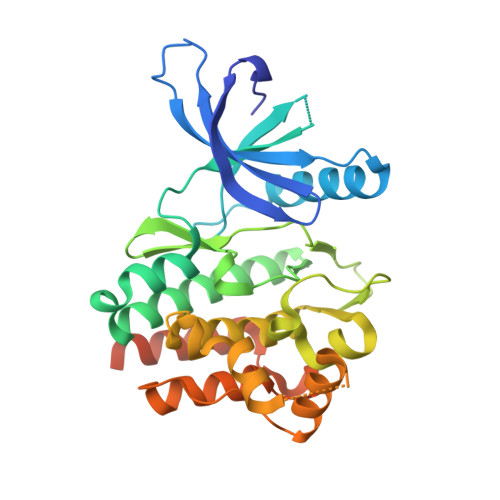3-Amido Pyrrolopyrazine JAK Kinase Inhibitors: Development of a JAK3 vs JAK1 Selective Inhibitor and Evaluation in Cellular and in Vivo Models.
Soth, M., Hermann, J.C., Yee, C., Alam, M., Barnett, J.W., Berry, P., Browner, M.F., Frank, K., Frauchiger, S., Harris, S., He, Y., Hekmat-Nejad, M., Hendricks, T., Henningsen, R., Hilgenkamp, R., Ho, H., Hoffman, A., Hsu, P.Y., Hu, D.Q., Itano, A., Jaime-Figueroa, S., Jahangir, A., Jin, S., Kuglstatter, A., Kutach, A.K., Liao, C., Lynch, S., Menke, J., Niu, L., Patel, V., Railkar, A., Roy, D., Shao, A., Shaw, D., Steiner, S., Sun, Y., Tan, S.L., Wang, S., Vu, M.D.(2013) J Med Chem 56: 345-356
- PubMed: 23214979
- DOI: https://doi.org/10.1021/jm301646k
- Primary Citation of Related Structures:
4HVD, 4HVG, 4HVH, 4HVI - PubMed Abstract:
The Janus kinases (JAKs) are involved in multiple signaling networks relevant to inflammatory diseases, and inhibition of one or more members of this class may modulate disease activity or progression. We optimized a new inhibitor scaffold, 3-amido-5-cyclopropylpyrrolopyrazines, to a potent example with reasonable kinome selectivity, including selectivity for JAK3 versus JAK1, and good biopharmaceutical properties. Evaluation of this analogue in cellular and in vivo models confirmed functional selectivity for modulation of a JAK3/JAK1-dependent IL-2 stimulated pathway over a JAK1/JAK2/Tyk2-dependent IL-6 stimulated pathway.
Organizational Affiliation:
Hoffmann-La Roche, 340 Kingsland Street, Nutley, New Jersey 07110, USA. michael.soth@roche.com
















